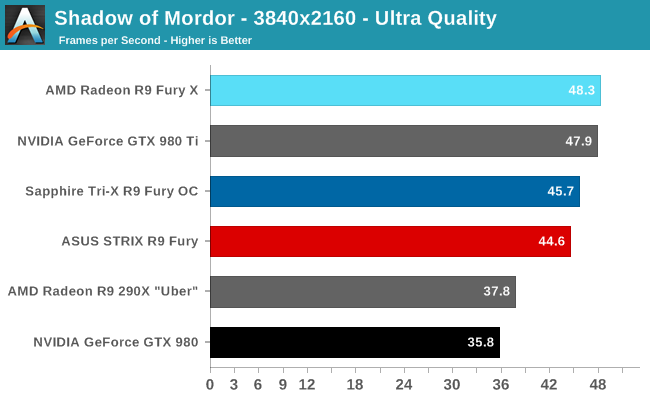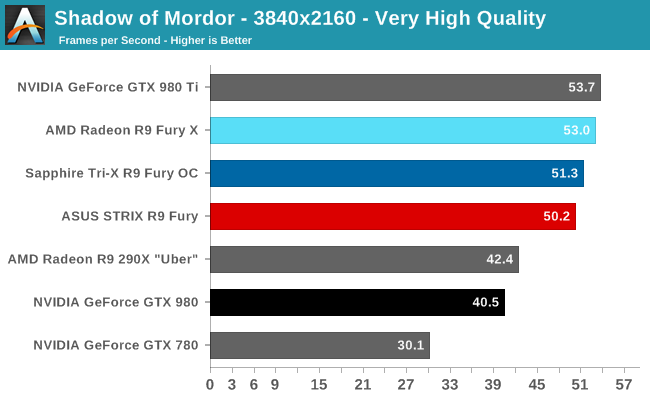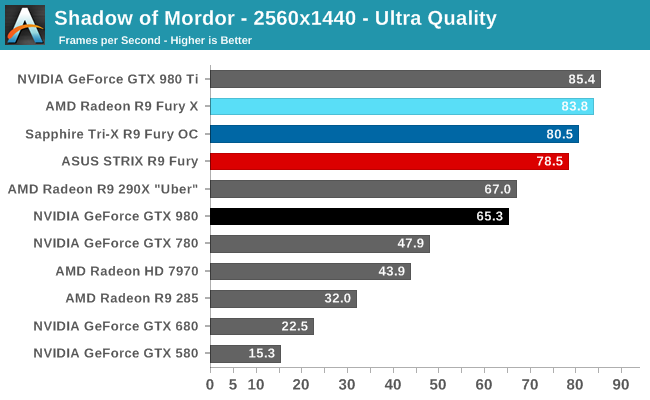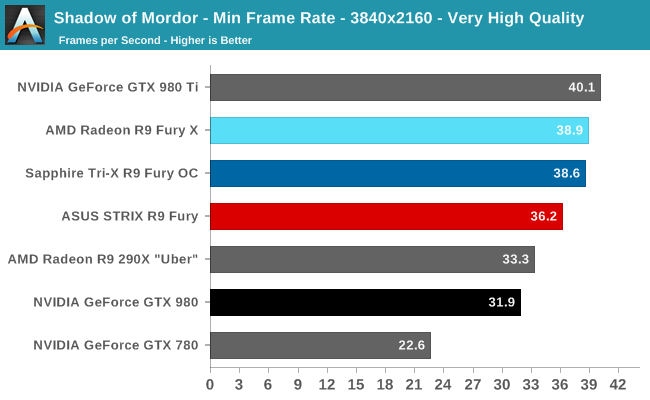The AMD Radeon R9 Fury Review, Feat. Sapphire & ASUS
by Ryan Smith on July 10, 2015 9:00 AM ESTMiddle Earth: Shadow of Mordor
Our next benchmark is Monolith’s popular open-world action game, Middle Earth: Shadow of Mordor. One of our current-gen console multiplatform titles, Shadow of Mordor is plenty punishing on its own, and at Ultra settings it absolutely devours VRAM, showcasing the knock-on effect that current-gen consoles have on VRAM requirements.



Shadow of Mordor ends up being a big win for AMD, with the R9 Fury cards shooting well past the GTX 980. Based on our earlier R9 Fury X review this was not an unexpected result, but at the end of the day with a 20%+ performance advantage, it’s a great situation for AMD to be in.
Meanwhile the R9 Fury’s performance relative to its X-rated sibling is yet again in the 7% range. So far the performance difference between the two cards is surprisingly consistent.
Finally, since AMD’s last two $550 cards were the R9 290X and HD 7970, let’s take a look at those comparisons quickly. At 1440p the R9 Fury only has a 17% lead over the R9 290X “Uber”, which for a card almost 2 years old is more than a bit surprising. The R9 Fury has more efficient front-ends and back-ends and significant advantages in shader throughput and memory bandwidth, and yet the performance gains compared to 290X are fairly small. On the other hand 7970 owners looking to upgrade to another Radeon should like what they’re seeing, as the R9 Fury’s 79% performance advantage is approaching upgrade territory.



Shifting gears to minimum framerates, the situation is similarly in AMD’s favor at 4K. One of the outcomes of going up against the GTX 980 is that it’s just as VRAM-limited as R9 Fury is, so in a VRAM intensive game like Shadow of Mordor, neither card has an advantage. However it’s quite interesting that once we back off to 1440p, the GTX 980 surges forward.










288 Comments
View All Comments
Goty - Friday, July 10, 2015 - link
Can you imagine the hassle upgrades would be with having to deal with two sockets instead of one?Oxford Guy - Saturday, July 11, 2015 - link
Not if the GPU socket standard is universal and backward compatible like PCI-E. It's only if companies get to make incompatible/proprietary sockets that that would be an issue.FlushedBubblyJock - Wednesday, July 15, 2015 - link
Yeah, let's put an additional 300 watts inside a socket laying flat on the motherboard - we can have a huge tube to flow the melting heat outside the case...Yep, that gigantic 8.9B trans core die, slap some pins on it... amd STILL loves pinned sockets...
Yeah, time to move to the motherboard ... ROFLMAO
I just can't believe it ... the smartest people in the world.
ant6n - Saturday, July 11, 2015 - link
I'm definitely interested to see how well these cards would do in a rotated atx Silverstone case. I have one of those, and I'm concerned about the alignment of the fins. You basically want the heat to be able to move up vertically, out the back/top of the card.ajlueke - Friday, July 10, 2015 - link
Priced in between the GTX 980 and the Fury X it is substantially faster than the former, and hardly any slower than the latter. Price performance wise this card is a fantastic option if it can be found around the MSRP, or found at all.FlushedBubblyJock - Wednesday, July 15, 2015 - link
NO, actually if you read, ha ha, and paid attention, lol, 10% more price for only 8% more performance... so it's ratio sucks compared to the NVIDIA GTX 980.Not a good deal, not good price perf compared to NVIDIA.
Thanks for another amd fanboy blowout
Nagorak - Friday, July 10, 2015 - link
One interesting thing from this review is looking at the performance of the older AMD cards. The improvement of the Fury vs the older cards was mentioned by Ryan Smith in the review, noting that performance hasn't improved that much. But there's a lot more to it than that. The relative performance of AMD's cards seem to have moved up a lot compared to their Nvidia competitors.Look at how the 290X stacks up against the GTX 780 in this review. It pretty much just blows it away. The 290X is performing close to the GTX 980 (which explains why the 390X which has faster memory is competitive with it). Meanwhile, the HD 7970 is now stacking up against the GTX 780.
Now, look back at the performance at the time the 290X was released: http://www.anandtech.com/show/7457/the-radeon-r9-2...
It looks like performance on AMD's GCN chips has increased significantly. Meanwhile the GTX 780's performance has at best stayed the same, but actually looks to have decreased.
Anandtech should really do a review of how performance has changed over time on these cards, because it seems the change has been pretty significant.
Nagorak - Friday, July 10, 2015 - link
I don't know, maybe it's just different benchmark settings but the AMD cards look to be a bit more competitive to their counterparts than they were at release.Stuka87 - Friday, July 10, 2015 - link
Its been the case with all GCN cards. AMD continues to make driver optimizations. The 7970 is significantly faster now that it was at launch. Its one advantage of them all sharing a similar architecture.FlushedBubblyJock - Wednesday, July 15, 2015 - link
nvidia CARDS GAIN 10-20% AND MORE over their release drivers... but that all comes faster, on game release days, and without massive breaking of prior fixes, UNLIKE AMD, who takes forever and breaks half of what it prior bandaided, and it takes a year or two or three or even EOL for that fix to come.